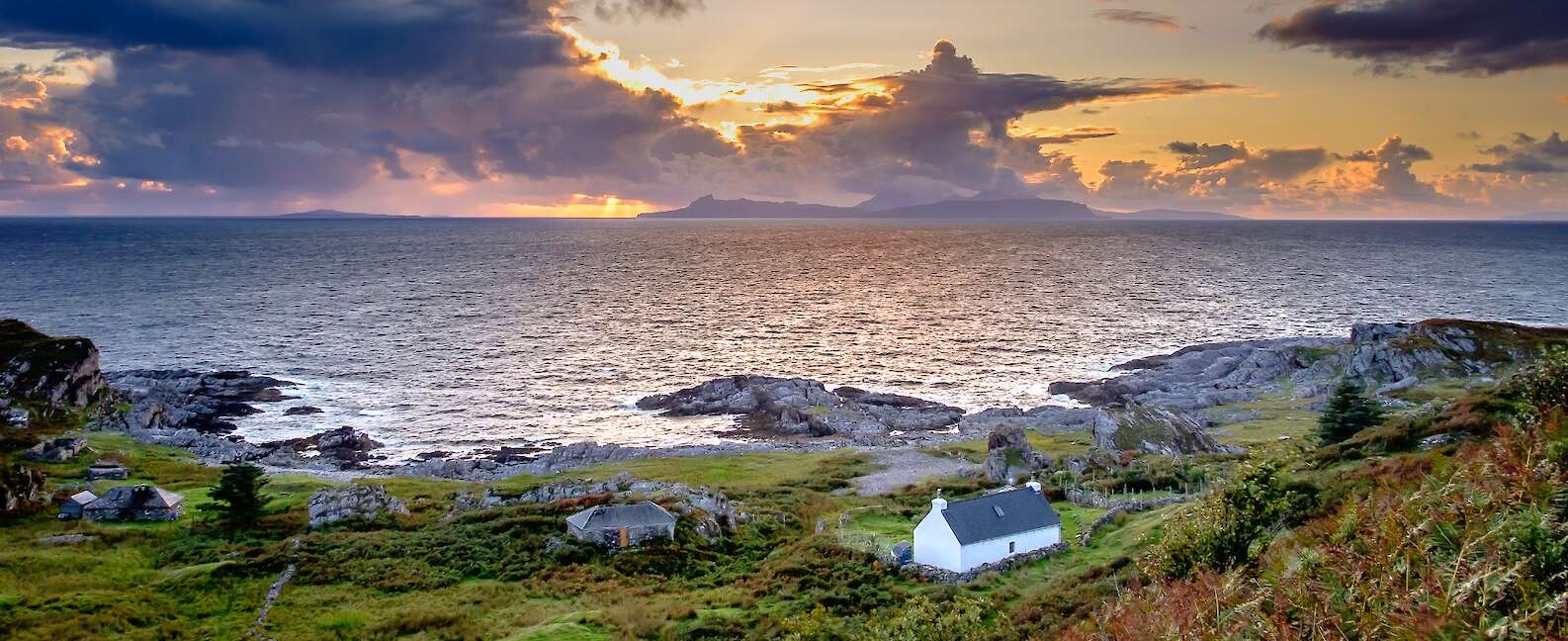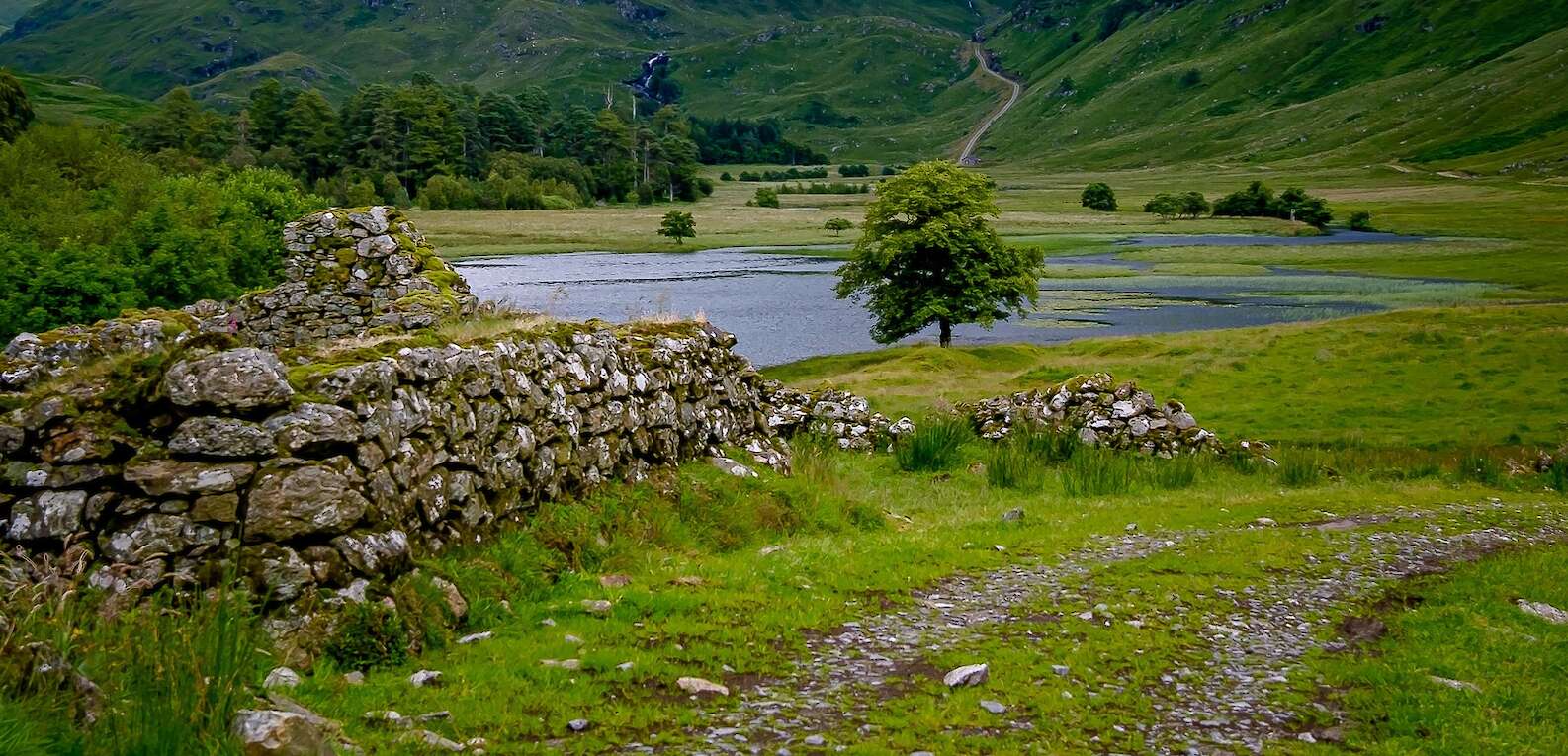The Peninsulas have a very ancient history, stretching from the Mesolithic people of over 6,000 years ago, through iron age settlers, to the Irish Saints who were followed by the Vikings. Then came the Highland Clans, followed by the Clearances and ultimately the formation of crofting communities which make up the many thriving townships and hamlets that exist today. All of this leaves much for budding historians to explore.

Pre-History
Some 10,000 years ago, in Mesolithic times, nomadic people left shell middens and tools on an island in Loch Sunart. Later, Neolithic farmers cleared the forests for fields and built chambered cairns – at Ormsaigmore, Camas nan Geall, and Swordle - Bronze Age farmers left hut circles, and there is ample evidence of Iron Age settlement.
Celtic Saints
In the sixth century, Irish Gaels began to colonise the area, then inhabited by Picts, and Ardnamurchan became part of the Celtic kingdom of Dalriada. Around 500 AD St. Finan founded a monastery in Loch Shiel on an island named after him. Fifty years later St. Columba is said to have rested at Ardslignish where he struck a rock with his stick and created the clear spring which still runs today. Around 700 AD, St. Comghan came from Leinster, founding the church (Gaelic 'Cill') of Comghan ('Koe-an' in English), giving Kilchoan its name.
Viking influences
From the late eighth century Vikings began to arrive from Scandinavia, first as invaders then as settlers. In the early ninth century Ketill Flatnefr (flat nosed) settled in Ormsaigmore and is buried in the Neolithic stone circle of Greadal Fhinn. Many coastal place names, such as Fascadale and Swordle, have Norse origins. In 2011 a Viking boat burial, complete with warrior chieftain and his weapons, was found at Swordle.
Around 1120, Somerled, a Scots/Norse chief of Morvern, defeated the Norwegian settlers south of Ardnamurchan, including the reputedly seven-foot tall Borrodill, after whom Glenborrodale is named.
The MacIains
Following Angus Og MacDonald’s support for Robert the Bruce at the Battle of Bannockburn in 1314, his brother, Iain Sprangach MacDonald, gained Ardnamurchan and founded the Clan MacIain. For over 300 years Mingary Castle was the seat of Clan MacIain, who became powerful within the MacDonald’s Lordship of the Isles.
The history of the MacIains of Ardnamurchan is a complex of feuds, battles, massacres, intrigues, treachery and misfortune. The MacIains’ star rose with the power of the Lordship of the Isles, and waned as the Scottish king and his supporters, the Campbells, asserted their control. After 1519, with the deaths of chieftain John and two of his sons at the battle of Creag an Airgid, the MacIain fortunes began to decline.
By the early 17th century the MacIains had lost Mingary and their lands and were reduced to piracy. Most of the remaining clan members were massacred in MacIains’ Cave on Ardnamurchan’s north coast, the rest either fleeing or joining other clans.
The 1715 Jacobite uprising Men from the area who rallied to the Royal Standard, raised by the Earl of Mar at Aberdeen, included Clanranald of Castle Tioram who died in the battle of Sherrifmuir. Tradition holds that Clanranald, knowing himself to be committed to an ill-fated venture, ordered the firing of his own castle as he left, rather than have it fall into the hands of his enemies.
Bonnie Prince Charlie & the ’45
In 1745 a French vessel anchored in Loch nan Uamh, just north of Ardnamurchan. Lachlan Campbell, the local Protestant minister and a Hanoverian supporter, realised that its mysterious passenger was the Young Pretender. While the prince headed up Loch Shiel to gather the clans at Glenfinnan, staying overnight at Dalilea, Campbell raised the alarm.
Clearances and Crofting
For generations, local people had lived in small villages, paying rent and providing armed men for their chiefs’ wars. After the ’45, clan leaders increasingly saw their lands and people as sources of funds to support their new social status. Ardnamurchan was sold as an estate to the Riddells, who ‘improved’ their holdings by making sheep farms, let to incoming farmers. The clansmen and their families were evicted, sometimes brutally. For example, the tenants of the small township of Buarblaig were cleared in 1828. Its remains can be visited on the east slopes of Ben Hiant above Camus Nan Geall.
Those evicted often left the area altogether, either to find work in places like Glasgow or for a new life abroad. Those that remained were moved onto
marginal land, each family being assigned a ‘croft’, a parcel of land designed to be too small to support a family, thus forcing the people to find paid employment from which to pay rent. New crofting townships created at this time include Sanna and Portuairk.
Two World Wars
Local war memorials commemorate the sacrifice of local people, plucked from this remote community to die in far off lands and seas. The ranks they achieved, like Regimental Sergeant Major Donald Nisbet of Kilchoan, demonstrate their ability and resourcefulness in the face of hardship and peril.
Commandos were toughened on the local terrain, convoys assembled in the sea lochs, and infantry practised invasion skills on northern beaches of Ardnamurchan. Three aircraft crashed locally, two safely on the soft sands of Sanna but a Hurricane crash on Druim na Gearr Leacainn killed its New Zealand pilot.
